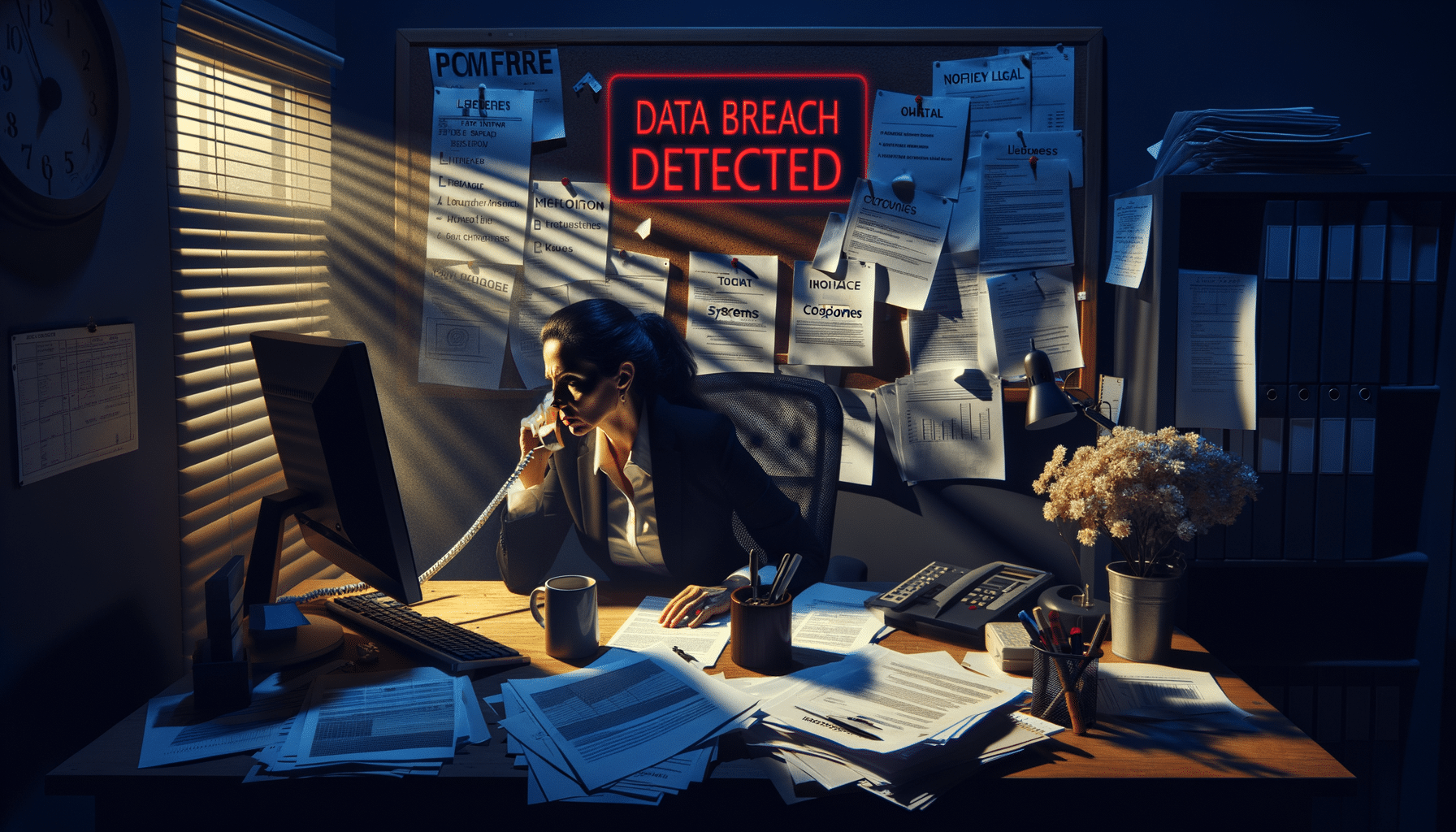Data breaches happen to everyone. Fortune 500 companies. Small businesses. Government agencies. Healthcare providers. When your organization becomes the next victim, panic sets in. But panic won’t help you recover. What you do in the first 24 hours after discovering a breach determines whether you’ll emerge stronger or face devastating consequences. The steps after a data breach occurs can mean the difference between minimal damage and complete business failure. I’ve worked with dozens of organizations through their worst cybersecurity moments. The companies that survive follow a clear, methodical approach. The ones that don’t? They scramble, make critical mistakes, and pay the price for years.
Key Takeaways
- Speed matters more than perfection – Your first 24-72 hours determine the scope of damage and legal exposure
- Document everything immediately – Poor documentation during breach response leads to regulatory fines and failed investigations
- Assemble your response team before you need them – Having legal counsel, forensic experts, and PR specialists on standby saves critical time
- Communication strategy prevents secondary damage – How you tell your story controls whether stakeholders abandon you or support your recovery
- Recovery planning starts during containment – Organizations that plan for business continuity while managing the crisis recover faster and stronger
Immediate Response: Critical Steps After a Data Breach Occurs
The moment you discover unauthorized access to your systems, your response clock starts ticking. Every minute counts. I’ve seen organizations lose millions because they hesitated or followed the wrong sequence of actions.
Contain the Breach
Stop the bleeding first. Your immediate priority is preventing further unauthorized access. This means:
- Isolate affected systems from your network without shutting them down completely
- Change all administrative passwords and revoke suspicious user access
- Preserve evidence by taking forensic images before making changes
- Document every action you take with timestamps and personnel involved
Don’t make the rookie mistake of powering down everything. You’ll destroy valuable forensic evidence and potentially make recovery harder. Instead, disconnect network cables or disable network interfaces to isolate compromised systems while keeping them running.
Activate Your Incident Response Team
If you don’t have a pre-established incident response team, you’re already behind. But don’t waste time building one from scratch now. Focus on these key roles:
- Incident Commander – Usually your CISO or IT director who makes final decisions
- Technical Lead – Your best systems administrator or security specialist
- Legal Counsel – External cybersecurity attorney, not your general business lawyer
- Communications Lead – Someone who can manage internal and external messaging
Your legal counsel should be involved from hour one. They’ll help you navigate notification requirements and maintain attorney-client privilege over your investigation. The FTC’s data breach response guide provides excellent baseline requirements, but every situation has unique legal complexities.
Begin Forensic Investigation
You need to understand what happened, when it started, and what data was accessed. This isn’t just about fixing the problem – it’s about meeting legal notification requirements and preventing future attacks.
Hire external forensic experts immediately. Your internal IT team is skilled, but they lack the specialized tools and experience for breach investigation. Plus, external experts provide credibility with regulators and law enforcement.
Key forensic questions to answer:
- How did the attacker gain initial access?
- What systems and data were accessed or exfiltrated?
- How long was the attacker in your environment?
- Are there signs of ongoing access or backdoors?
Legal and Regulatory Compliance After Data Breaches
Breach notification laws are complex, contradictory, and unforgiving. Miss a deadline or notification requirement? You’ll face regulatory fines that often exceed the cost of the breach itself.
Understand Your Notification Timeline
Different regulations have different timelines. You might be operating under multiple requirements simultaneously:
| Regulation | Notification Timeline | Who to Notify |
|---|---|---|
| GDPR | 72 hours to regulators, without undue delay to individuals | Data protection authorities, affected individuals |
| HIPAA | 60 days to individuals, 60 days to HHS | Patients, Department of Health and Human Services |
| State Laws (varies) | Typically 30-90 days | State attorney general, affected residents |
| PCI DSS | Immediately to card brands and acquirer | Payment card companies, acquiring bank |
The clock starts ticking from when you discover the breach, not when it occurred. This is why documenting your discovery timeline is critical. Regulators will scrutinize whether you should have discovered the breach earlier.
Determine Notification Requirements
Not every security incident requires notification. But determining whether your incident meets the threshold requires careful legal analysis. Key factors include:
- Types of data involved (personally identifiable information, health records, financial data)
- Number of individuals affected
- Likelihood of harm to affected individuals
- Whether data was encrypted or otherwise protected
I’ve seen organizations avoid notification requirements because their data was properly encrypted. But I’ve also seen companies face penalties for failing to notify when they should have. This decision requires legal expertise, not IT expertise.
Communication Strategy and Stakeholder Management
How you communicate about your breach determines whether stakeholders view you as a victim who handled a crisis professionally or as a negligent organization that can’t be trusted.
Internal Communications First
Before you tell anyone outside your organization, make sure your internal team is aligned. This includes:
- Executive leadership – They need to understand the scope, timeline, and potential business impact
- Key department heads – HR, legal, finance, and operations need to prepare for secondary effects
- All employees – They’ll hear about the breach eventually. Better they hear it from you first.
Control the narrative internally before external stakeholders start asking questions. Nothing looks worse than executives who seem surprised by their own breach.
Customer and Public Communication
Your breach notification letters and public statements will be scrutinized by regulators, lawyers, and the media. Every word matters.
Key principles for external communication:
- Be factual and specific, but don’t speculate beyond what you know
- Focus on what you’re doing to protect affected individuals
- Provide clear, actionable steps people can take to protect themselves
- Avoid technical jargon that makes you sound evasive
I recommend drafting your communications with input from legal counsel, your PR team, and customer service representatives. Legal counsel ensures compliance. PR ensures clarity. Customer service ensures you’re answering the questions people actually have.
Managing Media and Public Relations
The media will find out about your breach whether you tell them or not. CISA’s incident response guidelines emphasize the importance of coordinated public messaging during cybersecurity incidents.
Designate a single spokesperson and prepare them with key messages. Everyone else in your organization should refer media inquiries to that person. Mixed messages from different company representatives make you look disorganized and unprepared.
Business Recovery and Long-Term Response Planning
The steps after a data breach occurs don’t end when you’ve contained the incident and sent notification letters. Real recovery takes months or years. Organizations that plan for long-term recovery during their initial response recover faster and emerge stronger.
Operational Recovery
Getting back to normal operations requires more than just fixing your security. You need to:
- Rebuild affected systems from clean backups or new installations
- Implement additional security controls to prevent similar attacks
- Update policies and procedures based on lessons learned
- Retrain staff on new security requirements
Don’t rush back to full operations. I’ve seen organizations suffer second breaches because they prioritized speed over security during recovery. Take the time to do it right.
Financial Impact Assessment
Breach costs extend far beyond immediate response expenses. Plan for:
- Forensic investigation and legal fees
- Regulatory fines and penalties
- Credit monitoring services for affected individuals
- Increased cybersecurity insurance premiums
- Lost business from customer churn
- Litigation costs and potential settlements
Work with your finance team and insurance carriers to understand your coverage and potential out-of-pocket expenses. This information helps you make informed decisions about response investments.
Strengthening Security Posture
Every breach reveals security weaknesses. Use your incident response as an opportunity to build a more resilient security program:
- Conduct a comprehensive security assessment beyond the immediate breach cause
- Implement advanced threat detection and response capabilities
- Enhance employee security awareness training
- Review and update incident response procedures based on your experience
The organizations that emerge stronger from breaches are those that view the incident as a catalyst for comprehensive security improvements, not just a problem to solve.
Conclusion
Data breaches are inevitable, but devastating consequences aren’t. The steps after a data breach occurs determine whether you’ll face minimal disruption or existential threat to your organization. Speed, documentation, legal compliance, and strategic communication form the foundation of effective breach response. But remember – the best breach response starts before the breach happens. Build your incident response team, establish relationships with forensic experts and legal counsel, and practice your procedures regularly. When your breach happens – and it will happen – you’ll be ready to respond professionally and recover quickly.
Don’t wait until you’re in crisis mode to start planning. Begin building your breach response capabilities today.
FAQ
How quickly do I need to respond after discovering a data breach?
You should begin containment within hours of discovery. The specific steps after a data breach occurs must start immediately – every hour of delay increases potential damage and legal exposure. Regulatory notification requirements typically range from 72 hours to 90 days depending on applicable laws, but your internal response needs to begin immediately.
Do I need to hire external experts for breach response?
Yes, in most cases. External forensic investigators provide specialized expertise, maintain independence for legal proceedings, and often have tools and experience your internal team lacks. External legal counsel specializing in cybersecurity helps you navigate complex notification requirements and maintain attorney-client privilege over your investigation.
What’s the biggest mistake organizations make during breach response?
The biggest mistake is failing to document their response properly. Poor documentation leads to regulatory penalties, makes forensic investigation harder, and creates problems in potential litigation. Document every decision, every action taken, and maintain detailed timelines from the moment you discover the breach.
How do I know if my incident qualifies as a reportable data breach?
This depends on the types of data involved, the number of people affected, and applicable regulations. Generally, unauthorized access to personally identifiable information, health records, or financial data triggers notification requirements. However, the specific determination requires legal analysis of your situation and applicable laws. When in doubt, consult with cybersecurity legal counsel immediately.



